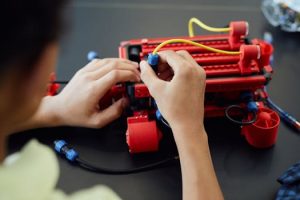AI Companions: The Evolution of Empathetic Robotics
The world of robotics and artificial intelligence (AI) is constantly evolving, pushing the boundaries of what we thought was possible. From self-driving cars to intelligent personal assistants, AI has made its mark in various industries. One particular field that has seen significant growth in recent years is that of AI companions. These empathetic robots have revolutionized the concept of human-robot interaction, blurring the lines between man and machine. In this article, we’ll explore the evolution of empathetic robotics and its impact on our daily lives.
The Rise of AI Companions
The idea of AI companions is not a new one. In fact, science fiction writers have been envisioning them for decades. However, it wasn’t until the late 20th century that researchers truly started exploring the possibility of creating empathetic robots. One of the earliest examples of this was the creation of the famous robot, Kismet, in 1997. Designed by Dr. Cynthia Breazeal, Kismet was able to interact with humans through facial expressions and speech, making it the first step towards creating a truly empathetic robot.
Since then, several advancements in AI technology have paved the way for the development of more sophisticated AI companions. In 2011, Apple introduced Siri, a voice-controlled personal assistant that could understand natural language and perform tasks based on voice commands. This was followed by Amazon’s Alexa and Google Assistant, both of which have become part of our daily lives, assisting us with various tasks and making our lives easier.
The Evolution of Empathetic Robotics
Emotional Intelligence and Natural Language Processing
One of the key elements that differentiate empathetic robots from their predecessors is emotional intelligence. By integrating natural language processing (NLP) and emotion recognition algorithms, AI companions can interpret and respond to human emotions, making them more relatable and human-like.
For example, Replika, an AI companion app, is designed to be a digital copy of the user, using NLP to learn and emulate the user’s personality and respond accordingly. This not only allows for more personalized interactions but also builds an emotional connection between the user and their AI companion.
Facial and Gesture recognition
Another significant development in empathetic robotics is the integration of facial and gesture recognition technology. Through computer vision, AI companions can analyze human expressions and gestures, making them capable of understanding non-verbal cues, just like humans do. This allows them to respond appropriately, making them seem more human-like and enhancing their ability to form emotional connections with their users.
One example of this is Pepper, a humanoid robot designed by SoftBank Robotics. Pepper’s facial recognition technology allows it to recognize and greet people, making eye contact and responding to their emotions accordingly. This has made it a popular attraction in retail stores, where it serves as a personal greeter and provides product information to customers.
The Impact on Society
The rise of AI companions has not only transformed the way we interact with robots but also has a significant impact on our society. With the increasing demand for personalization and human-like interactions, empathetic robotics is revolutionizing customer service, healthcare, and education industries.
In healthcare, empathetic robots are being used to assist in therapy and rehabilitation, providing patients with a sense of companionship and motivation. In schools, robots like Milo are helping children with autism improve their social and communication skills. These are just a few examples of how AI companions are making a positive impact on society.
The Ethical Considerations
As with any emerging technology, there are ethical considerations surrounding the use of empathetic robots. The biggest concern is whether these robots will one day surpass human capabilities and consciousness, causing them to become a threat to humanity. There are also concerns about data privacy and the potential for manipulation through emotional connections with AI companions.
Concluding Thoughts
The evolution of empathetic robotics has come a long way, and the potential for its future growth is immense. Despite ethical concerns, AI companions have changed the way we interact with technology, blurring the lines between humans and robots. With further advancements in AI technology, we can expect empathetic robots to become an integral part of our daily lives, providing companionship, assistance, and emotional support.
In conclusion, AI companions have opened up a whole new world of possibilities, and their impact on society will only continue to grow. It is up to us to ensure that we use this technology responsibly and ethically, harnessing its potential for the betterment of our world.











